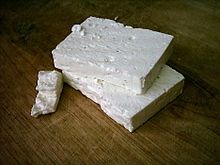Feta cheese

Feta cheese (Greek: φέτα, feminine gender; pronounced ˈfɛta (tiːˈʀiː)), or simply Feta is a kind of cheese. Usually it is made from the milk of sheep or goats. Feta cheese originally is from the Greek mainland, or from Lesbos in the Aegean Sea.
It is an ingredient in a Greek Salad.
Other cheese (which is usually not from Greece and is usually made from cow milk) must not be called Feta from 2007. The European Court said so in its decisions C-465/02 and C-466/02 (from October 25, 2005).
This ruling is only valid for the European Union, and other countries in Europe. Several member state of the WTO still think that the term "feta" is generic.[1] European Member states wanted to ddefend this protected designation of origin at the WTO talks in Doha.[2]
History
[change | change source]What is now called feta cheese was known to Ancient Greeks. Homer must have known about it. There were several references to the cheese in the Odyssey. According to the myth, the cyclops Polyphemos was the first cheese manufacturer. He carried the milk in animal-skin bags. He had collected the milk from his sheep. He was very surprised to see that days later the milk had become solid. When Polyphemus tried to eat it, it tasted well. He also found that as such a solid, it would go bad later than with milk.
The name Feta has an Italian origin. It is derived from fetta (slice), and dates back to the 17th century. Very likely this referred to the method of cutting the cheese in slices to put it in barrels.
References
[change | change source]- ↑ Implications of Article 23 extension Archived 2016-03-04 at the Wayback Machine PDF. Communication from Australia, Canada, Guatemala, New-Zealand, Paraguay, the Philippines and the United States, World Trade Organization, 26/07/2002
- ↑ WTO talks: EU steps up bid for better protection of regional quality products[permanent dead link] PDF, Bruxelles, 28 août 2003
Other websites
[change | change source]- Feta registered as Protected Designation of Origin
- https://www.feta.gr on feta's history, production and conservation methods, plus dozens of recipes with feta
